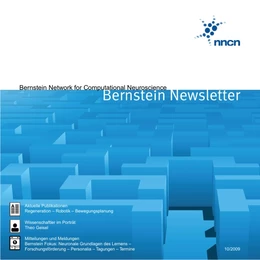Bernstein Newsletter

Nerve cells provide neighborly aid
The visual cortex of the brain analyzes and processes neuronal signals originating from the retina. When parts of the retina are injured, the corresponding regions in the visual cortex no longer receive any input signals.
The respective spot in the visual field gets proverbially “dark” – a scotoma forms. Plasticity processes in the brain’s visual cortex can, at least partly, restore the ability to see: after reorganization of the network, the cells that are deprived of input signals from the retina receive input signals from other cells. But which cells provide this new input? In order to find an answer to this question, Dirk Jancke, Bernstein Group Computational Neuroscience – in a cooperation project with the Ulf Eysel, Medical Faculty at the Ruhr-University of Bochum – observed regeneration processes after retinal lesions in rats. The researchers showed that strengthening of neuronal connections to neighboring cells of the visual cortex play an important role here.The image that falls on the retina is projected to the visual cortex in such a way that topology is maintained; neighboring regions on the retina are processed by neighboring neurons in the visual cortex. The cells in the visual cortex, however, do not only receive input signals from the retina; they are also widely interconnected. The scientists around Jancke managed to show that these contacts are further strengthened during regeneration processes. “For quite some time, there have been studies describing such plastic processes. Until now, however, these processes could not be visualized functionally over relatively large areas of the visual cortex,” Jancke explains.The scientists from Bochum observed the processes in the visual cortex with a new method that makes use of voltage-sensitive dyes. They change their fluorescence when cells receive or send electrical signals. By applying this imaging method, the activity of neuronal cell populations can be captured with high spatial and temporal resolution. Shortly after the retinal lesion, the cells in the affected region of the visual cortex showed no or only little activity. But within only a few weeks after the lesion, neuronal activity waves increasingly spread from neighboring regions into the affected region. “Cortical nerve cells, which are suddenly deprived of direct input after a retinal lesion, are at least enabled to look around the corner again thanks to the connection to still-functional distant neighbors,” Jancke points out. Lacking image information is replaced by information from neighboring regions. The restoration of the function of cortical neurons after injuries is a central subject in neuroscience. The retinal lesion model provides an ideal access in order to systematically explore the basic principles of such neuronal reorganization processes in the cortical network.
Link to newsletter
http://homepage.ruhr-uni-bochum.de/Dirk.Jancke/Bernstein_NL14_Jancke_2-3.pdf (deutsch/english)
Related video for download